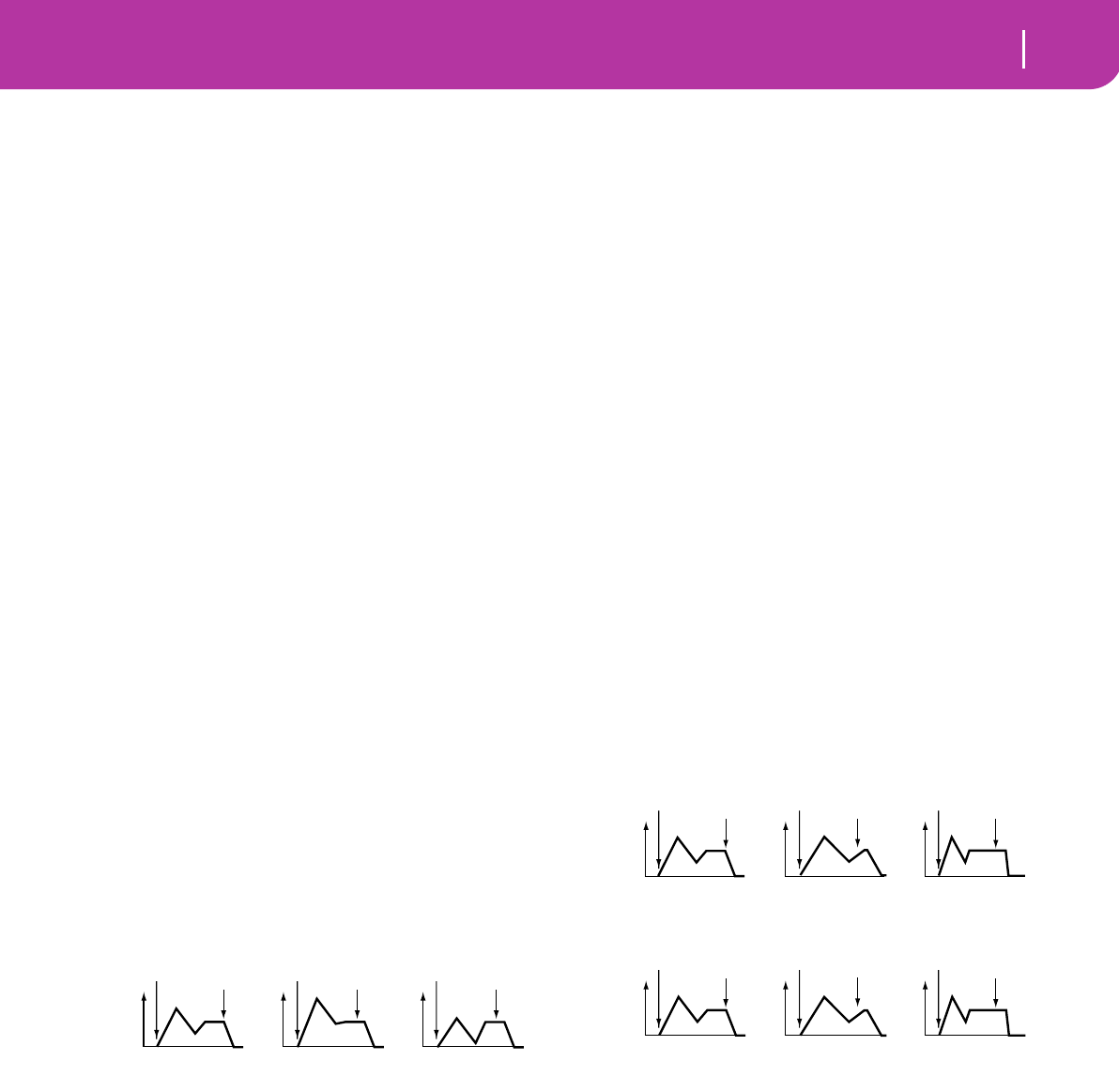
119
Program operating mode
Page 16 - Amp EG
Start Level
This parameter specifies the volume level at note-on. If you
want the note to begin at a loud level, set this to a high value.
Attack Level
This parameter specifies the volume level that will be reached
after the attack time has elapsed.
Break Level
This parameter specifies the volume level that will be reached
after the decay time has elapsed.
Sustain Level
This parameter specifies the volume level that will be main-
tained from after the slope time has elapsed until note-off
occurs.
Attack/Decay/Slope/Release Time
These parameters specify the time over which the volume
change will occur.
0…99 Time value.
Attack Time
This parameter specifies the time over which the volume will
change after note-on until it reaches the attack level. If the
start level is 0, this will be the rise time of the sound.
Decay Time
This parameter specifies the time over which the volume will
change from when it reaches the attack level until it reaches
the break point level.
Slope Time
This parameter specifies the time over which the volume will
change from when it reaches the break point level until it
reaches the sustain level.
Release Time
This parameter specifies the time over which the volume will
change after note-off until it reaches 0.
Amp EG ‘Level’ modulation
AMS(L) (Alternate Modulation Source)
This parameter specifies the source that will control the
“Level” parameters of the amp EG. See “AMS (Alternate
Modulation Source) list” on page 123.
Intensity
This parameter specifies the depth and direction of the effect
that “AMS” will have. For example, if “AMS” is Velocity, set-
ting “Start Level Swing”, “Attack Level Swing” and “Break
Point Level Swing” to + and setting “Intensity” to a positive
(+) value will cause the amp EG volume levels to increase as
you play more strongly. Setting “Intensity” to a negative (–)
values will cause the amp EG volume levels to decrease as you
play more strongly. With a setting of 0, the levels will be as
specified on “Page 16 - Amp EG”.
-99…+99 Intensity value.
Start Level Swing
This parameter specifies the direction in which “AMS” will
change “Start Level”. If “Intensity” is set to a positive (+)
value, setting this parameter to + will allow AMS to increase
the EG level, and setting this parameter to – will allow AMS
to decrease the EG level. With a setting of 0, no change will
occur.
Attack Level Swing
This parameter specifies the direction in which “AMS” will
change “Attack Level”. If “Intensity” is set to a positive (+)
value, setting this parameter to + will allow AMS to increase
the EG level, and setting this parameter to – will allow AMS
to decrease the EG level. With a setting of 0, no change will
occur.
Break Point Level Swing
This parameter specifies the direction in which “AMS” will
change “Break Level”. If “Intensity” is set to a positive (+)
value, setting this parameter to + will allow AMS to increase
the EG level, and setting this parameter to – will allow AMS
to decrease the EG level. With a setting of 0, no change will
occur.
Amp EG ‘Time’ modulation
These parameters let you use an alternate modulation source
to modify the amp EG times that were specified in “Attack/
Decay/Slope/Release Time” on page 119.
AMS1(T) (Alternate Modulation Source 1 - Time)
This parameter specifies the source that will control the
“Time” parameters of the amp EG (see “AMS (Alternate
Modulation Source) list” on page 123). With a setting of Off,
there will be no modulation.
Intensity
This parameter specifies the depth and direction of the effect
that “AMS1” will have. For example, if “AMS1(T)” is Amp
KTrk +/+, the (Amp) Keyboard Track settings (see “Amplifier
keyboard tracking” on page 117) will control the EG “Time”
parameters. With positive (+) values of this parameter, posi-
tive (+) values of “Ramp (Ramp Setting) will cause EG times
to be lengthened, and negative (–) values of “Ramp (Ramp
Setting)” will cause EG times to be shortened. The direction
of the change is specified by “Attack Time Swing”, “Decay
Time Swing”, “Slope Time Swing”, and “Release Time”.
When “AMS1(T)” is Velocity, positive (+) values will cause
EG times to lengthen as you play more strongly, and negative
Amp 1 EG changes (Level) (AMS=Velocity, Intensity = a positive (+) value)
Note-on
Note-off
Note-on
Note-off
Note-on
Note-off
Softly played note when Start Level
Swing=0 and Attack Level Swing
and Breack Level Swing are set to +
Strongly played note when Start Level
Swing=0 and Attack Level Swing and
Breack Level Swing are set to +
Strongly played note when Start Level
Swing=0 and Attack Level Swing and
Breack Level Swing are set to +
Amp 1 EG changes (Time) (AMS=Velocity, Intensity= a positive (+) value)
Amp 1 EG changes (Time)
(AMS=Amp KTrk +/+, Intensity = a positive (+) value)
(When Amp Keyboard Track “Low Ramp”= a positive (+) value, and
“High Ramp” = a positive (+) value)
Note-on
Note-off
Note-on
Note-off
Note-on
Note-off
Note-on
Note-off
Note-on
Note-off
Note-on
Note-off
Low-pitched note played with
Attack, Decay, Slope, and
Release Time Swing at +
Softly played note with
Attack, Decay, Slope and
Release Time Swing at +
High -pitched note played with
Attack, Decay, Slope, and
Release Time Swing at –
Strongly played note with
Attack, Decay, Slope and
Release Time Swing at +
Strongly played note with
Attack, Decay, Slope and
Release Time Swing at –


















